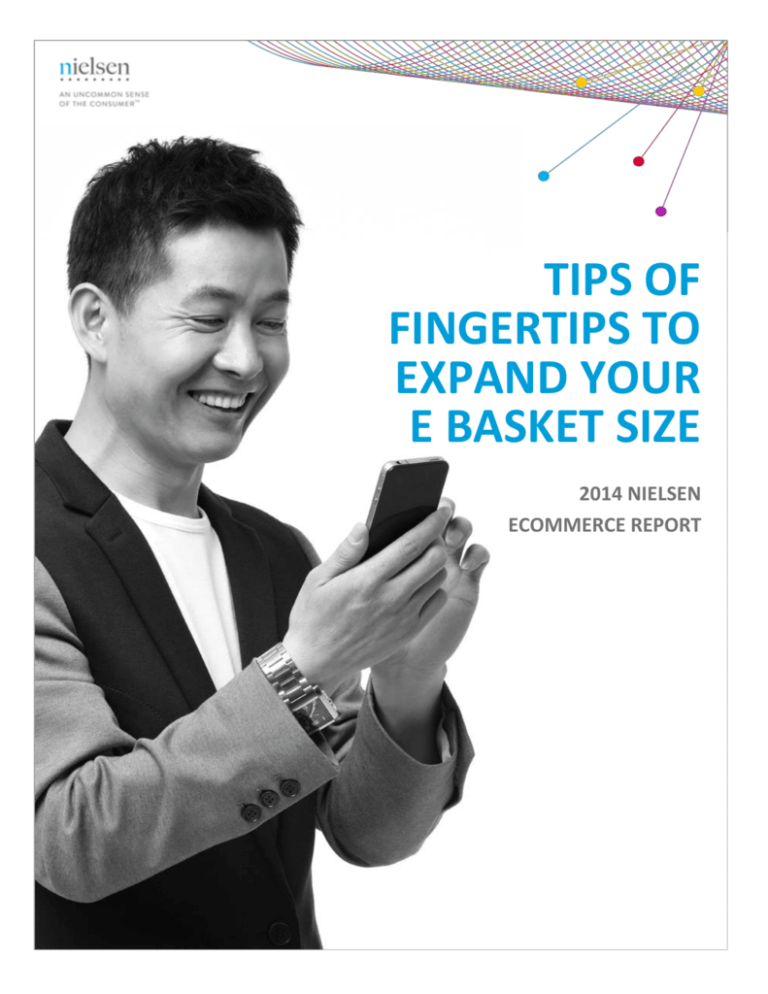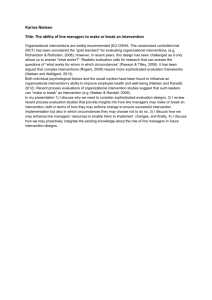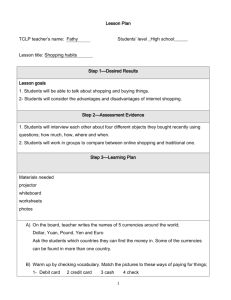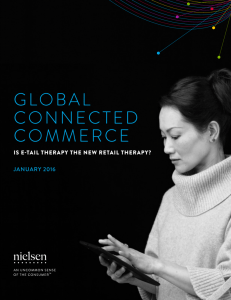Manufacturer Proposal Template
advertisement

TIPS OF FINGERTIPS TO EXPAND YOUR E BASKET SIZE 2014 NIELSEN ECOMMERCE REPORT eCommerce is no longer “to do or not to do”. It’s now all about how to do it successfully before consumers for you. However, if you want to do successfully in eCommerce, you have to understand your consumers’ online shopping behaviour. Online purchase intentions around the world have doubled since 2011 for many durable and entertainment-related categories including e-books, event tickets, sporting goods and toys, according to a new study conducted online by Nielsen. Nearly half of global respondents intend to make an online purchase in the next six months in high-prominence categories including clothing (46%), airline (48%) and hotel (44%) reservations. Comparing to the global average, Taiwan online consumers show high intentions toward online shopping. The hot categories in Taiwanese consumers’ eBasket The top five online purchasing categories for Taiwan consumers are clothing/accessories/shoes (45%), tours/hotel reservations (42%), airline ticket/reservations (38%), event tickets (movie, performance/exhibition/game, etc., 36%) and groceries (food and beverages, 32%). The lightning-fast pace of change in the digital landscape has ushered in a consumer mindset that is both adventurous and exploratory when it comes to online shopping. Consumers everywhere want a good product at a good price, and the seemingly limitless options available in a virtual environment provide new opportunities for both merchants and consumers. The market for fast-moving consumer goods (FMCG) is no exception, especially when the FMCG growth rate in Taiwan on physical channels is only 0.4 percent. The Nielsen Global Survey of e-commerce polled more than 30,000 Internet respondents in 60 countries to examine the TAIWAN CONSUMERS APPEAR TO KNOW HOW TO LEVERAGE PHYSICAL AND VIRTUAL CHANNELS FOR THEIR BEST INTERESTS—MORE THAN TWO-THIRDS (68%) “OFTEN LOOK AT PRODUCTS ONLINE BEFORE PURCHASING THEM IN THE STORE” AND MORE THAN HALF (52%) “OFTEN CHECK OUT PRODUCTS IN THE STORE BEFORE PURCHASING THEM ONLINE.” online shopping and purchasing intentions of consumers worldwide. The study provides clarity about global consumers’ buying intentions for both consumable and non-consumable categories in the growing e-commerce landscape. When it comes to shopping for airline tickets or making reservations for tours and hotels, and looking for clothes, there is mostly a one-to-one correlation between online searching and shopping—those who browse online also buy online, with less than 10 percent gap for each category. In contrast, products more conducive to online browsing than buying include: mobile phones, electronic equipment, computer hardware/software, and cars/motorcycles. The browse-to-buy difference for these products is over 20 percentage points. Taiwanese consumers: “we enjoy the best benefits from both brick & mortar and online retailers” Taiwan consumers appear to know how to leverage physical and virtual channels for their best interests—more than twothirds (68%) “often look at products online before purchasing them in the store” and more than half (52%) “often check out products in the store before purchasing them online.” Now is the time to create omni-channel experiences for consumers who are actively using both digital and physical platforms to research and purchase, as consumers increasingly don’t make a distinction between the two. Convenience and detailed product information are the key factors that attract Taiwan consumers to the online channel. Over three-fourths (77%) of Taiwan respondents said “Shopping online is convenient,” close to seven-in-ten (69%) claimed “I like to read online reviews prior to purchasing a product,” and two-thirds would spend considerable time researching products online prior to buying. Price also matters. More than half said they can usually get the best price buying products online and “deals at online retailers are better than those in stores” (both 52%). Though over three-in-five (63%) feel shopping online is fun, the percentage is still 10 percentage less than Asia Pacific average. Convenience and price are very basic criteria for online shopping platforms in Taiwan and the critical issue for online players now is how to increase the frequency of the shopping/purchasing. Providing a good product experience with full detailed product information and reviews and creating interesting online shopping environment will guide consumers to enjoy shopping. While computers (83%) are the favored device for online browsing and buying for Taiwan respondents, mobile phones are a close second choice with 45% of respondents using the device for online shopping—7 percentage points lower than the Asia Pacific average of 52%. Mobile phone usage is also popular in Middle East/Africa (55%). Nielsen study shows the ascendancy of the mobile device as a primary device for e-commerce consumers around the globe. The use of these devices introduces all sorts of questions for retailers and manufacturers alike. For instance, will consumers still make shopping trips—buying a whole basket full of items at a time—or will consumers shop throughout the day, one or two items at a time, shifting from retailer to retailer in the process? How will these potentially new shopping patterns impact age-old practices? Over the coming year or two, the industry will need to examine these habits in more detail. Global Consumers: Online Buying or Browsing? When it comes to shopping for clothes, event tickets, books and toys, or making reservations for tours and hotels, there is mostly a one-to-one correlation between online searching and shopping—those who browse online also buy online. NIELSEN STUDY SHOWS THE ASCENDANCY OF THE MOBILE DEVICE AS A PRIMARY DEVICE FOR E-COMMERCE CONSUMERS AROUND THE GLOBE. THE USE OF THESE DEVICES INTRODUCES ALL SORTS OF QUESTIONS FOR RETAILERS AND MANUFACTURERS ALIKE. Consumable products, on the other hand, have lower online browse/buy intention rates than non-consumable products, but their browse-to-buy correlation rates are just as strong. For example, with cosmetics, 33 percent of global respondents say they browse, and 31 percent say they buy: nearly a one-to-one correlation. Similarly, about one-third of global respondents say they browse and buy personal care products (31%/29%) and groceries (30%/27%). About one-fourth browse and buy pet products (24%/21%) and baby supplies (23%/20%), and roughly one-fifth browse/buy flowers (20%/18%) and alcoholic drinks (20%/17%). Strong online browse-to-buy conversion rates for fast-moving consumer goods translates to loyal repeat customers for these categories. While these categories are still in the early stages of online adoption, these correlation rates signal great news for online retailers. Products more conducive to online browsing than buying include: electronic equipment, mobile phones, computer hardware/software, sporting goods, videos/DVDs/games and cars/motorcycles. These products can carry a high price tag and often require a try-before-you-buy test run. The browseto-buy difference for these products averages about 7 percentage points. Developing Markets Race to Embrace E-commerce According to Nielsen’s study, consumer appetite for online browsing is strongest in the largely developing regions of Latin America and Asia-Pacific, with both regions surpassing the global average for all 22 categories in the study. However, while online browsing rates are highest in Latin America, online buying rates for the region are the lowest for just about every category in the study. Conversely, online buying rates in AsiaPacific are the highest of any region—so high that buying rates exceed browsing rates for more than half (14) of the categories. Latin Americans are enthusiastic online shoppers, but the online retail infrastructure has not yet caught up with offering conversion opportunities. Other barriers to e-commerce success include Internet access, shipping costs, high taxes and problematic delivery logistics. Asia is the farthest down the ecommerce maturity curve—in Asia-Pacific, tech-savvy consumers have already embraced the convenience of online shopping. Attracting new buyers using mobile could be an accelerator in developing markets, as it provides greater and faster access to more people. Online browsing and buying percentages are similar in Europe, North America and the Middle East/Africa, with a few exceptions, based on availability and opportunity. In the developed region of North America and largely developed region of Europe, shopping options proliferate, and online retailing represents another channel competing for market share. On the other hand, in the Middle East/Africa region, lower-than-average online percentages can largely be attributed to opportunity—or lack thereof. In a region where disposable income is low and shopping for daily needs is the norm, online shopping is not a priority. Nielsen expects that will change as more consumers continue to move up the socioeconomic ladder. Device Differential While computers are the favored device for online browsing and buying among respondents in all regions, mobile phones are a close second choice for respondents in the Middle East/Africa region, with 55% of respondents using the device for online shopping—11 percentage points higher than the global average of 44%. Similarly, mobile phone usage is popular in Asia-Pacific (52%) and Latin America (48%). One-third of European respondents (33%) and more than one-fourth (27%) of North Americans use their mobile phones to shop. About the Nielsen Global Survey The Nielsen Global Survey of E-commerce was conducted between Feb. 17 and March 7, 2014, and polled more than 30,000 consumers in 60 countries throughout Asia-Pacific, Europe, Latin America, the Middle East, Africa and North America. The sample has quotas based on age and sex for each country based on its Internet users and is weighted to be representative of Internet consumers. It has a margin of error of ±0.6 percent. This Nielsen survey is based only on the behavior of respondents with online access. Internet penetration rates vary by country. Nielsen uses a minimum reporting standard of 60 percent Internet penetration or an online population of 10 million for survey inclusion. The Nielsen Global Survey, which includes the Global Consumer Confidence Index, was established in 2005. About Nielsen Nielsen (NYSE:NLSN) is a leading information and media group worldwide specializing in marketing, consumer information, television and other media measurement, online intelligence information, and communication measurement. Nielsen’s business activities distribute over approximately 100 countries globally; the headquarters are located in New York, USA, and Diemen, the Netherlands. Please refer the details at: www.nielsen.com










